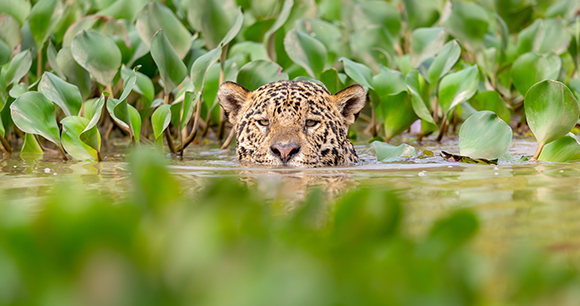Using Computer Simulations to Study Jaguar Gene Flow Through Mexico
The preservation of large carnivores such as jaguars will not be achieved only by conserving isolated protected areas. They need large landscapes. Subpopulations need to mix genes to remain genetically robust; therefore, animals must move between protected areas, through landscapes dominated by human activity. Our understanding of how individual movement and human-wildlife conflict affect regional population persistence is poorly understood, as, traditionally, it would require large-scale trapping of jaguars to outfit them with radio collars to monitor their movements over time.

This study, supported by a Christine Stevens Wildlife Award, demonstrated the ability of a spatially explicit, individual-based “SimFelid” computer model, implemented in the HexSim simulation platform, to capture the complex movements of jaguars. It showed how a model populated with biological data on jaguars from published studies can be used to generate predictions of wildlife movements relevant to management decisions made by field biologists and conservation practitioners. The “SimFelid” model is finely tuned to account for sex-specific territoriality, sex-specific juvenile dispersal behavior, and behaviors specific to available resources, roads, and rivers. As this work is based on computer simulations, it is completely noninvasive.
The model was used to predict how two locally implemented conservation strategies impact regional jaguar population dynamics: (1) assisted juvenile migration via “stepping stones”—small, high-quality habitat patches between protected areas, and (2) reducing retaliatory poaching near urban areas.
Two major results from this study are of particular relevance to jaguar conservation: One is that the stepping stone simulation showed that very small changes to the landscape can greatly enhance movement and therefore significantly improve genetic connectivity between the subpopulations of the region. Specifically, improving the habitat quality of seven 13.75 km2 areas in Mexico resulted in a 25 percent improvement in gene flow by facilitating jaguar movement between higher-quality habitats. These results support the use of even very small migration stepping stones to improve future genetic resilience of jaguars.
The second is that human-caused mortality associated with urban areas is predicted to have profound effects on jaguar subpopulation “source-sink dynamics” (i.e., how various habitats affect population growth or decline—ecological “sources” experience more births than deaths, while the opposite is true for ecological “sinks”). Absent urban-associated mortality, most of the subpopulations acted as sources. However, when urban proximity and mortality is factored in, three subpopulations in the southern Yucatan peninsula (those furthest from urban centers) became the dominant sources in the region while the remainder became sinks. Therefore, conservation practitioners may wish to secure the preservation of those southern Yucatan subpopulations prior to investing in conservation measures for subpopulations near urban areas that may be acting as sinks.
This study aimed to demonstrate the capacity of spatially explicit, individual-based computer simulations to model the complex movement ecology of jaguars, thereby offering a replacement for large-scale trapping and collaring field studies. The results demonstrate how biologically detailed computer models can successfully capture complex movement behavior and improve our predictive ability by (1) generating predictions over large geographic areas that would be untenable via traditional methods, (2) manipulating anthropogenic impact scenarios in a geographically realistic manner relevant to conservation practitioners, and (3) enabling predictions of how conservation efforts affect the gene pool over multiple generations, even when generation times are long and movement behavior is complex.
This study was funded by the Christine Stevens Wildlife Awards program. Learn more about this program or view additional studies.
Program Terms: Terrestrial Wildlife
AWI Quarterly Terms: Feature Article
Related News
IUCN Reaffirms Long-Tailed Macaques’ Endangered Status Despite Industry Pressure
In Program: Terrestrial WildlifeThe International Union for Conservation of Nature (IUCN) today released an update to its Red List of Threatened Species. The update revealed that the long-tailed...
AWI Funds Research to Alleviate Human-Wildlife Conflicts, Animal Suffering
In Program: Terrestrial WildlifeThe Animal Welfare Institute (AWI) announced today the eight recipients of its Christine Stevens Wildlife Award who are developing humane solutions to human-wildlife conflicts and...
Refuge from Cruel Trapping Act Reintroduced to Protect Wildlife and Pets on Public Lands
In Program: Companion Animals, Terrestrial WildlifeThe Animal Welfare Institute (AWI) endorses the Refuge from Cruel Trapping Act, reintroduced today in the US House of Representatives by Rep. Jerrold Nadler (D-NY)....
Colorado Now Leads Country in Comprehensive Approach to Fighting Wildlife Trafficking
In Program: Terrestrial WildlifeToday, Colorado Gov. Jared Polis signed S.B. 25-168 into law to combat wildlife trafficking. The bipartisan legislation, which is unique among states for the number...